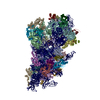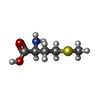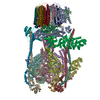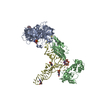+ Open data
Open data
- Basic information
Basic information
| Entry | Database: PDB / ID: 3j81 | ||||||
|---|---|---|---|---|---|---|---|
| Title | CryoEM structure of a partial yeast 48S preinitiation complex | ||||||
 Components Components |
| ||||||
 Keywords Keywords |  RIBOSOME / eukaryotic translation initiation / 48S / small ribosome subunit RIBOSOME / eukaryotic translation initiation / 48S / small ribosome subunit | ||||||
| Function / homology |  Function and homology information Function and homology informationformation of translation initiation ternary complex / methionyl-initiator methionine tRNA binding / Recycling of eIF2:GDP / ABC-family proteins mediated transport / translation reinitiation / eukaryotic translation initiation factor 2 complex / multi-eIF complex / eukaryotic 43S preinitiation complex /  protein-synthesizing GTPase / formation of cytoplasmic translation initiation complex ...formation of translation initiation ternary complex / methionyl-initiator methionine tRNA binding / Recycling of eIF2:GDP / ABC-family proteins mediated transport / translation reinitiation / eukaryotic translation initiation factor 2 complex / multi-eIF complex / eukaryotic 43S preinitiation complex / protein-synthesizing GTPase / formation of cytoplasmic translation initiation complex ...formation of translation initiation ternary complex / methionyl-initiator methionine tRNA binding / Recycling of eIF2:GDP / ABC-family proteins mediated transport / translation reinitiation / eukaryotic translation initiation factor 2 complex / multi-eIF complex / eukaryotic 43S preinitiation complex /  protein-synthesizing GTPase / formation of cytoplasmic translation initiation complex / formation of translation preinitiation complex / eukaryotic 48S preinitiation complex / positive regulation of translational fidelity / Formation of the ternary complex, and subsequently, the 43S complex / Translation initiation complex formation / Ribosomal scanning and start codon recognition / Formation of a pool of free 40S subunits / protein-synthesizing GTPase / formation of cytoplasmic translation initiation complex / formation of translation preinitiation complex / eukaryotic 48S preinitiation complex / positive regulation of translational fidelity / Formation of the ternary complex, and subsequently, the 43S complex / Translation initiation complex formation / Ribosomal scanning and start codon recognition / Formation of a pool of free 40S subunits /  ribosomal small subunit binding / L13a-mediated translational silencing of Ceruloplasmin expression / translation regulator activity / regulation of translational fidelity / ribosomal small subunit binding / L13a-mediated translational silencing of Ceruloplasmin expression / translation regulator activity / regulation of translational fidelity /  translation initiation factor binding / translational initiation / translation initiation factor binding / translational initiation /  translation initiation factor activity / cytosolic ribosome / maintenance of translational fidelity / rRNA processing / translation initiation factor activity / cytosolic ribosome / maintenance of translational fidelity / rRNA processing /  ribosomal small subunit assembly / cytoplasmic stress granule / cytosolic small ribosomal subunit / ribosomal small subunit assembly / cytoplasmic stress granule / cytosolic small ribosomal subunit /  ribosome binding / ribosome binding /  double-stranded RNA binding / small ribosomal subunit / cytoplasmic translation / cytosolic large ribosomal subunit / double-stranded RNA binding / small ribosomal subunit / cytoplasmic translation / cytosolic large ribosomal subunit /  rRNA binding / rRNA binding /  ribosome / structural constituent of ribosome / ribosome / structural constituent of ribosome /  translation / translation /  ribonucleoprotein complex / ribonucleoprotein complex /  mRNA binding / mRNA binding /  GTPase activity / GTP binding / GTPase activity / GTP binding /  protein kinase binding / protein kinase binding /  RNA binding / zinc ion binding / RNA binding / zinc ion binding /  metal ion binding / metal ion binding /  nucleus / nucleus /  cytosol / cytosol /  cytoplasm cytoplasmSimilarity search - Function | ||||||
| Biological species |   Saccharomyces cerevisiae (brewer's yeast) Saccharomyces cerevisiae (brewer's yeast)  Kluyveromyces lactis (yeast) Kluyveromyces lactis (yeast)synthetic construct (others) | ||||||
| Method |  ELECTRON MICROSCOPY / ELECTRON MICROSCOPY /  single particle reconstruction / single particle reconstruction /  cryo EM / Resolution: 4 Å cryo EM / Resolution: 4 Å | ||||||
 Authors Authors | Hussain, T. / Llacer, J.L. / Fernandez, I.S. / Savva, C.G. / Ramakrishnan, V. | ||||||
 Citation Citation |  Journal: Cell / Year: 2014 Journal: Cell / Year: 2014Title: Structural changes enable start codon recognition by the eukaryotic translation initiation complex. Authors: Tanweer Hussain / Jose L Llácer / Israel S Fernández / Antonio Munoz / Pilar Martin-Marcos / Christos G Savva / Jon R Lorsch / Alan G Hinnebusch / V Ramakrishnan /   Abstract: During eukaryotic translation initiation, initiator tRNA does not insert fully into the P decoding site on the 40S ribosomal subunit. This conformation (POUT) is compatible with scanning mRNA for the ...During eukaryotic translation initiation, initiator tRNA does not insert fully into the P decoding site on the 40S ribosomal subunit. This conformation (POUT) is compatible with scanning mRNA for the AUG start codon. Base pairing with AUG is thought to promote isomerization to a more stable conformation (PIN) that arrests scanning and promotes dissociation of eIF1 from the 40S subunit. Here, we present a cryoEM reconstruction of a yeast preinitiation complex at 4.0 Å resolution with initiator tRNA in the PIN state, prior to eIF1 release. The structure reveals stabilization of the codon-anticodon duplex by the N-terminal tail of eIF1A, changes in the structure of eIF1 likely instrumental in its subsequent release, and changes in the conformation of eIF2. The mRNA traverses the entire mRNA cleft and makes connections to the regulatory domain of eIF2?, eIF1A, and ribosomal elements that allow recognition of context nucleotides surrounding the AUG codon. | ||||||
| History |
|
- Structure visualization
Structure visualization
| Movie |
 Movie viewer Movie viewer |
|---|---|
| Structure viewer | Molecule:  Molmil Molmil Jmol/JSmol Jmol/JSmol |
- Downloads & links
Downloads & links
- Download
Download
| PDBx/mmCIF format |  3j81.cif.gz 3j81.cif.gz | 2.1 MB | Display |  PDBx/mmCIF format PDBx/mmCIF format |
|---|---|---|---|---|
| PDB format |  pdb3j81.ent.gz pdb3j81.ent.gz | 1.6 MB | Display |  PDB format PDB format |
| PDBx/mmJSON format |  3j81.json.gz 3j81.json.gz | Tree view |  PDBx/mmJSON format PDBx/mmJSON format | |
| Others |  Other downloads Other downloads |
-Validation report
| Arichive directory |  https://data.pdbj.org/pub/pdb/validation_reports/j8/3j81 https://data.pdbj.org/pub/pdb/validation_reports/j8/3j81 ftp://data.pdbj.org/pub/pdb/validation_reports/j8/3j81 ftp://data.pdbj.org/pub/pdb/validation_reports/j8/3j81 | HTTPS FTP |
|---|
-Related structure data
| Related structure data |  2763MC  2764C  3j80C M: map data used to model this data C: citing same article ( |
|---|---|
| Similar structure data |
- Links
Links
- Assembly
Assembly
| Deposited unit | 
|
|---|---|
| 1 |
|
- Components
Components
-RNA chain , 3 types, 3 molecules 213
| #1: RNA chain |  18S ribosomal RNA 18S ribosomal RNAMass: 579545.875 Da / Num. of mol.: 1 / Source method: isolated from a natural source / Source: (natural)   Kluyveromyces lactis (yeast) Kluyveromyces lactis (yeast) |
|---|---|
| #36: RNA chain | Mass: 24223.482 Da / Num. of mol.: 1 / Source method: obtained synthetically / Details: In vitro transcribed tRNA, aminoacylated |
| #37: RNA chain |  Messenger RNA Messenger RNAMass: 7786.572 Da / Num. of mol.: 1 / Source method: obtained synthetically / Source: (synth.) synthetic construct (others) |
+Protein , 38 types, 38 molecules ABCDEFGHIJKLMNOPQRSTUVWXYZabcf...
-Protein/peptide , 1 types, 1 molecules h
| #35: Protein/peptide | Mass: 3354.243 Da / Num. of mol.: 1 Source method: isolated from a genetically manipulated source Source: (gene. exp.)   Saccharomyces cerevisiae (brewer's yeast) Saccharomyces cerevisiae (brewer's yeast)Production host:   Escherichia coli (E. coli) / References: UniProt: P0CX86 Escherichia coli (E. coli) / References: UniProt: P0CX86 |
|---|
-Non-polymers , 3 types, 85 molecules 




| #43: Chemical | ChemComp-MG / #44: Chemical | #45: Chemical | ChemComp-MET / |  Methionine Methionine |
|---|
-Experimental details
-Experiment
| Experiment | Method:  ELECTRON MICROSCOPY ELECTRON MICROSCOPY |
|---|---|
| EM experiment | Aggregation state: PARTICLE / 3D reconstruction method:  single particle reconstruction single particle reconstruction |
- Sample preparation
Sample preparation
| Component |
| ||||||||||||||||||||||||||||||||
|---|---|---|---|---|---|---|---|---|---|---|---|---|---|---|---|---|---|---|---|---|---|---|---|---|---|---|---|---|---|---|---|---|---|
| Molecular weight | Value: 1.2 MDa / Experimental value: NO | ||||||||||||||||||||||||||||||||
| Buffer solution | Name: 20 mM MES-KOH, 40 mM potassium acetate, 10 mM ammonium acetate, 8 mM magnesium acetate, 2 mM DTT pH: 6.5 Details: 20 mM MES-KOH, 40 mM potassium acetate, 10 mM ammonium acetate, 8 mM magnesium acetate, 2 mM DTT | ||||||||||||||||||||||||||||||||
| Specimen | Conc.: 0.17 mg/ml / Embedding applied: NO / Shadowing applied: NO / Staining applied : NO / Vitrification applied : NO / Vitrification applied : YES : YES | ||||||||||||||||||||||||||||||||
| Specimen support | Details: Quantifoil R2/2 400 mesh copper grids with 4-5 nm thin carbon on top | ||||||||||||||||||||||||||||||||
Vitrification | Instrument: FEI VITROBOT MARK I / Cryogen name: ETHANE / Temp: 120 K / Humidity: 100 % Details: Blot for 2.5 seconds before plunging into liquid ethane (FEI VITROBOT MARK I) Method: Blot for 2.5 seconds before plunging |
- Electron microscopy imaging
Electron microscopy imaging
| Experimental equipment |  Model: Tecnai Polara / Image courtesy: FEI Company |
|---|---|
| Microscopy | Model: FEI POLARA 300 / Date: Oct 28, 2013 Details: Complete dataset was collected in 5 non-consecutive days |
| Electron gun | Electron source : :  FIELD EMISSION GUN / Accelerating voltage: 300 kV / Illumination mode: FLOOD BEAM FIELD EMISSION GUN / Accelerating voltage: 300 kV / Illumination mode: FLOOD BEAM |
| Electron lens | Mode: BRIGHT FIELD Bright-field microscopy / Nominal magnification: 78000 X / Calibrated magnification: 104478 X / Nominal defocus max: 4000 nm / Nominal defocus min: 1600 nm / Cs Bright-field microscopy / Nominal magnification: 78000 X / Calibrated magnification: 104478 X / Nominal defocus max: 4000 nm / Nominal defocus min: 1600 nm / Cs : 2 mm : 2 mm |
| Specimen holder | Specimen holder type: GATAN LIQUID NITROGEN |
| Image recording | Electron dose: 28 e/Å2 / Film or detector model: FEI FALCON II (4k x 4k) |
| Image scans | Num. digital images: 1791 |
| Radiation wavelength | Relative weight: 1 |
- Processing
Processing
| Software | Name: REFMAC / Version: 5.8.0077 2014/05/16 / Classification: refinement / Contact author: Garib N. Murshudov / Contact author email: garib[at]mrc-lmb.cam.ac.uk Description: (un)restrained refinement or idealisation of macromolecular structures | ||||||||||||||||||||
|---|---|---|---|---|---|---|---|---|---|---|---|---|---|---|---|---|---|---|---|---|---|
| EM software |
| ||||||||||||||||||||
CTF correction | Details: Each particle | ||||||||||||||||||||
| Symmetry | Point symmetry : C1 (asymmetric) : C1 (asymmetric) | ||||||||||||||||||||
3D reconstruction | Resolution: 4 Å / Resolution method: FSC 0.143 CUT-OFF / Num. of particles: 29698 / Nominal pixel size: 1.34 Å / Actual pixel size: 1.34 Å Details: The local resolution for chains k and l (lower-case chain IDs) is worse than the rest of the map. Therefore, these chains were docked as a rigid body into an 8 Angstrom-resolution low-pass ...Details: The local resolution for chains k and l (lower-case chain IDs) is worse than the rest of the map. Therefore, these chains were docked as a rigid body into an 8 Angstrom-resolution low-pass filtered map and then edited to remove clashes. The quality of this portion of the model is to be considered lower than the rest of the model. Symmetry type: POINT | ||||||||||||||||||||
| Atomic model building | Protocol: FLEXIBLE FIT / Space: RECIPROCAL / Target criteria: R-factor, FSC / Details: REFINEMENT PROTOCOL--flexible | ||||||||||||||||||||
| Atomic model building | 3D fitting-ID: 1 / Source name: PDB / Type: experimental model
| ||||||||||||||||||||
| Refinement | Details: HYDROGENS HAVE BEEN ADDED IN THEIR RIDING POSITIONS | ||||||||||||||||||||
| Refinement step | Cycle: LAST
|
 Movie
Movie Controller
Controller











 PDBj
PDBj




































